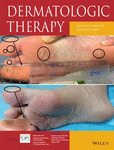Long-term effects of omalizumab on peripheral blood cells and C-reactive protein levels in patients with chronic spontaneous urticaria
Abstract
Omalizumab's mechanism of action is not well-understood yet despite its strong therapeutic efficacy in chronic spontaneous urticaria (CSU). To determine the overall effect of omalizumab on peripheral blood cell counts and serum C-reactive protein levels (sCRP) during a 1-year follow-up in patients with CSU. Data of 74 patients (male/female: 20/54) were reviewed from medical charts. Leucocyte counts, percentages of peripheral blood cells(lymphocyte, monocyte, neutrophil [PPBN], eosinophil, basophil [PPBB]) and sCRP were recorded at baseline, 3rd, 6th, 12th months of omalizumab treatment. Although a dramatic increase in the mean PPBB (±SD) was observed at the 3rd month, PPBB (%) gradually decreased after the 3rd month (PPBB: 0.38 ± 0.21 [baseline] vs. 0.59 ± 0.3 [3rd month], p = .002). However, 12th month PPBB remained higher than baseline (PPBB:0.38 ± 0.21 [baseline] vs. 0.46 ± 0.27 [12th month], p = .03). A dramatic decrease in the mean PPBN (%) was noticed within the first 3 months (PPBN:62.85 ± 8.97 [baseline] vs. 58.37 ± 9.07 [3rd month], p = .04), and 12th month PPBN remained lower than baseline values (PPBN: 62.85 ± 8.97 [baseline] vs. 60.31 ± 8.02 [12th month], p = .045).Mean sCRP (mg/dL) decreased rapidly within the first 3 months (sCRP: 1.09 ± 1.53 [baseline] vs. 0.56 ± 0.45 [3rd month], p = .17) and 12th month sCRP still remained lower than baseline levels (sCRP: 1.09 ± 1.53 [baseline] vs. 0.83 ± 1.06 [12th month], p = .01). Omalizumab substantially increases PPBB,and reduces PPBN accompanied by a reduction in sCRP especially in the first 3 months; however, these effects may continue in the long-term. The alterations in peripheral blood cell ratios and sCRP may contribute to the therapeutic effect of omalizumab in CSU.
CONFLICT OF INTEREST
The authors have no conflict of interest to declare.




